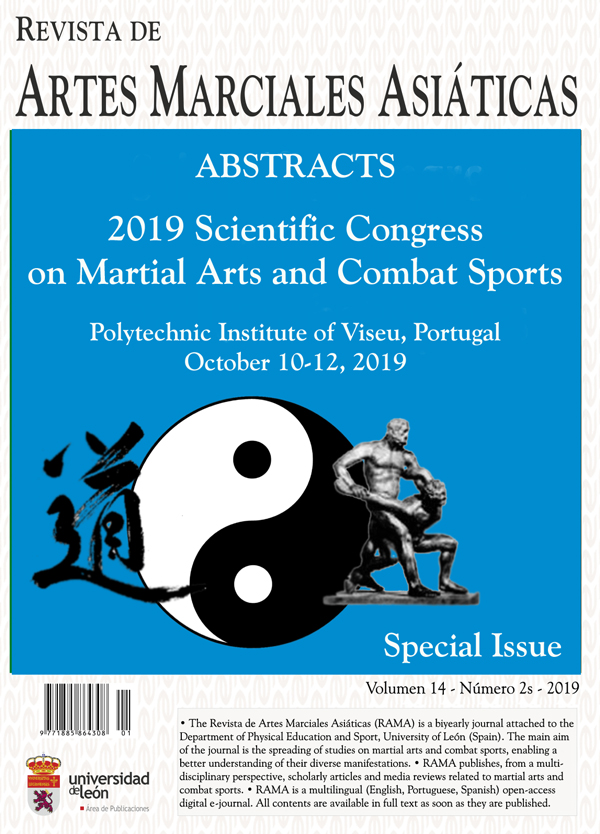Karate's ambiguity: Traditional martial art or modern combat sport
DOI:
https://doi.org/10.18002/rama.v14i2s.6000Keywords:
Martial arts, combat sports, traditional karate, toti, gendai, budo, bouts contests, kata contestsAbstract
After a radical conversion of the old Okinawan, anti-samurai martial art toti in the 1920s, a new, in effect Japanese modern combat sport, karate, came into being. The very first karate sports contest already took place in 1930. But, at the end of 1950s, karate started to be exported to the Western world as a traditional martial art of Japanese samurai, even if the samurai had not known karate. That then already omnipresent doctrine has allowed no other perception despite the fact that, globally, the prevalent phenomenon in the field has been karate sports contests in bouts and katas. Exposing the concept of karate as a traditional martial art to be an unhistoric, artificial ideological superstructure, this study is based on more than 50 years of accumulated scepticism of the author that has been confirmed through communication with students of various karate styles and the evaluation of several publications and studies. It is hoped that the findings of this basic study will encourage the sports scientific community to favor further research directed to indisputable and unambiguous explanation of karate.
Downloads
Métricas alternativas
References
Cynarsky, W.J. (2014). The European karate today: The opinion of experts. Ido movement for culture. Journal of martial arts anthropology, 14(3), 10-21. doi: https://doi.org/10.14589/ido.14.3.2
Funakoshi, G. (1975). Karate-do My Way of Life. Tokyo, New York, San Francisco: Kodansha America.
Haines, B. A. (1968). Karate's History and Traditions. Tokyo: Rutland.
Jakhel, R. (1998). Modern Sports Karate. Basics of Technique and Tactics. Aachen: Meyer&Meyer Verlag.
Jakhel, R. (2017-18). Borilni športi – 2. del: Karate in sorodne discipline. Kompendij predavanj [Combat sports – Vol. 2: Karate and related disciplines. Compendium of lectures]. Ljubljana: Faculty of Sport.
Jakhel, R., & Pieter, W. (2013). Changes in participation motives in karate 1970-1999. Ido movement for culture. Journal of martial arts anthropology, 13(1), 48-57. doi: https://doi.org/10.14589/ido.13.1.7
Kanazawa, H. (2011). Kumite shotokan karate. Masberg: Plaidt.
Lind, W. (1995a). Budo – Der geistige Weg der Kampfkünste. O.W. Barth Verlag: Bern, München, Wien.
Lind, W. (1995b). Die klassische Kata – Der geistige Herkunft und Praxis des traditionellen Karate. O.W. Barth Verlag: Bern, München, Wien.
Lind, W. (1997). Okinawa Karate – Geschichte und Tradition der Stille. SVB Sportverlag: Berlin.
Lind, W. (1999). Das Lexikon der Kampfkünste. SVB Sportverlag: Berlin.
Nakayama, M. (1978). Best karate: Kumite 1. Tokyo: Kodansha International.
Swenen, F. (2009). The Evolution of Karate: From Secret Martial Art to Worldwide Cultural Sport. Retrieved from http://sfdojo.be/wp-content/uploads/2014/05/ThesisBudai.pdf
Downloads
Published
How to Cite
Issue
Section
License
Copyright (c) 2019 Rudolf Jakhel

This work is licensed under a Creative Commons Attribution-NonCommercial-ShareAlike 4.0 International License.
The authors who publish in this journal must agree to the following terms:
- The authors grant on a nonexclusive basis the exploitation rights (reproduction, distribution, public communication and transformation) of the work accepted for publication to the University of León. The authors can establish, on their own, additional agreements for the non-exclusive distribution of the version of the work published in the journal (for example, placing it in an institutional repository or publishing it in a book), always acknowledging the initial publication in this journal.
- This work is licensed under the Creative Commons Attribution-NonCommercial-ShareAlike 4.0 International License. Click to see basic information and the legal text of the license.
- The authors are allowed and encouraged to disseminate electronically pre-print or post-print versions of their work before publication, as this can give rise to productive exchanges, as well as earlier and increased citing of the works published.











